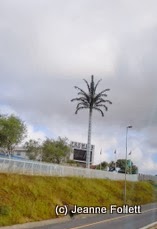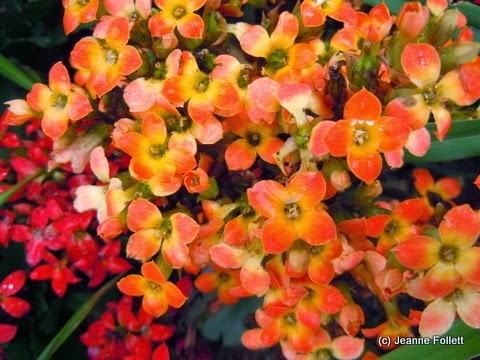The Africa Journals
Chapter 21
Marching to Pretoria
I'm with you and
You're with me and
So we are all together,
So we are all together,
So we are all together. :|
We are marching to Pretoria,
Pretoria, Pretoria.
We are marching to Pretoria,
Pre-to-ri-a today!
You're with me and
So we are all together,
So we are all together,
So we are all together. :|
We are marching to Pretoria,
Pretoria, Pretoria.
We are marching to Pretoria,
Pre-to-ri-a today!
—Marching song of disputed
origins*
Apparently,
it’s my purpose on this trip to keep Brian amused. I’d been trying to mend my self-image of a klutz,
especially after I realized how many times poor Brian had bent over to retrieve
whatever I’d dropped on the floor of the safari vehicles.
We
stop at the highway rest stop on the way back to Johannesburg. I reboard the coach and realize I have an
empty Coke Zero bottle to dispose of. I
look around and see a trash can about 20 yards away, so I get off the coach and get rid
of the bottle.
 |
| Cell tower "palm" |
Naturally,
I’m looking around the area and go to the wrong side of the coach to re-board. Well, it would be the right side in the US,
so it’s understandable. Not only do
South Africans drive on the wrong side, put their escalators on the opposite
side, the coach doors are on the wrong side too.
Brian
is chuckling when I finally get on. “It’s
on the other side,” he offers. And
then! One of the passengers points out
the rubbish can right beside the coach.
This tickles Brian no end.
Six hours after being back in Johannesburg, and I still haven’t gotten myself into some kind of jam. I successfully negotiate a visit to the attached mall, and explore several floors, all without getting lost, finding myself stuck in an elevator ( I took the escalators), or otherwise giving Brian cause for concern. Or mirth.
He, Brian, was off to the airport to pick up six more travelers, so we have the afternoon and evening free. I order a pastrami sandwich (incredibly the smallest-sounding item on the menu) in one of the very busy restaurants in the mall. When I start to pay the bill, though, I go brain dead trying to figure a 10 or 20 per cent tip on the $86 rand bill, which I am charging to my credit card. I can figure it in dollars, but not in rands.
Three men from our group are at a nearby table, so I approach them and ask for help. It must have been my unexpected question, but the same malady seizes them. Finally, one has a solution: Give the server 100 rand in cash. "But that's ten dollars!" I exclaim. We all do the mental math and settle on 10 rand, which is around a dollar. Ten per cent is the tipping norm in South Africa.
No 5 A.M. wake-up call for safari the next morning. Instead, we sleep in until the civilized hour of 7 o’clock, for an 8:30 departure to Pretoria, the capital of South Africa.
“Today,” says Brian once we are on the coach and headed out of Johannesburg (hereinafter referred to as Joburg), “we will visit two towns. One is Euro-centric and the other is Afro-centric.”
Euro-centric is based on European culture and standards, while Afro-centric, obviously, is based on traditional African culture and standards.
But first, a short 20-minute stop at a nearby mall for those who need to purchase necessary items they may have forgotten. I wander, purchase some nuts in a small shop, and find a restroom. Then I return to the coach. Brian asks if we are ready and looks specifically at me. I couldn’t help myself; the devil made me do it.
“I was trapped in the restroom stall,” I said. Brian laughs and shakes his head. Well, I was. The knob had to be turned to extremes to release the latch and it took a bit to discover that. I'd been hoping Brian had a better opinion of me than that of a doofus he had to watch every moment, but I think I just reinforced it. I had at least stopped dropping my water bottles and pens and notebook in safari vehicles—all of which he picked up for me.
We drive through the wide streets in downtown Pretoria, their width based on the radius of a turning oxcart. There are tens of thousands of jacaranda trees in Pretoria which set the city ablaze with purple blooms in October and November, but not now, not in February.
We pass the home of Paul Kruger, renowned as the face of resistance to the British annexation of the Transvaal. He was elected president of the Transvaal several times, and tried to keep the Boer lands free of British rule. Unfortunately for the Dutch Boers, gold was discovered in their lands and that, after the Boer Wars, was the end of independence from Britain.
 |
| It is said that more political business was done on this veranda than in any parliament house. |
Kruger National Park is named after him, as is the Krugerrand coin.
Unquestionably,
the strongest influence on South African culture and politics was the Dutch
reformed church, which taught a severe Calvinist ethos, including apartheid
and stratification of people according to race. The church forbade business dealings on
Sunday so all businesses were closed on that day.
As
a result, said Brian, people were advised to not go skydiving on Sundays
because nothing would open, not even parachutes. (The jokes got worse as the trip went on This one was actually one of the best.))
We
pass pedestrians looking for cabs and making particular hand signals to indicate
their destination (local, out of city).
The cabs honked when they were available.
Brian
warns us against using the minivan taxis as their drivers believe the laws
were for others, not them. Driving on
sidewalks, wrong way on one-way streets, nothing stands in their way.
One
of the most popular minivans used as taxis is the Toyota HiAce, which has been
interpreted by wags to mean “High Impact African Culling Equipment,” according to Brian.
 |
| The lawless mini-van taxis. |
We go to see the parliament house, known as the Union Buildings, built on the highest point overlooking this modern city. The semi-circular building is composed of two wings joined at the middle, representing the union of a once-divided country.
In front of the building is a bronze statue of Nelson Mandela, nine meters high, with his arms out-stretched, symbolic of embracing the nation as a whole. Erected following his death late last year, it is situated where Mandela made his inaugural speech after being installed as president of the country.
Around and below the statue are exquisitely tiered gardens containing only native plants.
 |
| Painting, cell phone in the other hand. |
I had heard something before I left Alaska on this trip. Apparently a statue of Mandela was creating quite a fuss because the sculptors had violated a ‘no signature” provision. They had placed a small rabbit sculpture in Mandela’s ear, in lieu of signing their work.
I ask Brian. He thinks that statue is elsewhere. I look and don’t see anything in Mandela’s ear canal.
I use the 21x zoom on my camera.
 |
| HAH! |
We leave the Union Buildings and drive through an area where most of the foreign embassies are located. Pretoria is host to more foreign embassies than any city in the world but Washington D.C
South Africa’s history is tortured and convoluted. Its record in dealing with the indigenous peoples is a nightmare.
The coach turns toward Soweto, where many of those nightmares occurred in real life. It is also the place where ordinary men became extraordinary.
*Marching to Pretoria, sung by every kid who ever was a Scout or who
attended summer camp and wondered where the heck Pretoria was and why they were
marching there, is of disputed origin. Various
sources claim it was sung by the Dutch Boers when they left Cape Town and
trekked to the interior of southern Africa (Pretoria) to escape British rule. Others claim it to be a marching song sung
by British soldiers as they advanced on the Boers during the 2nd Boer
War, more specifically by troops under the command of Lord Robert Baden-Powell,
who is considered the father of the Scouting movement. Whatever its origin, it is a song about
relying on your fellow marchers.















A lot of history I can well imagine. Loved the multi-tasking artist with a cell phone in his ear. Here I thought that was an activity solely here in the United States amongst our teen-agers. It looks like some serious traffic there based on your photo(s). Based on your telephoto of the rabbit in the ear of Nelson Mandela I have to assume you are NOT using the Nikon Coolpix series of cameras at all times. Beautiful flowers are beautiful flowers where ever one goes on this earth! Nice photos. Smiles .. Cap and Patti ..
ReplyDeleteAh, ah, ah. Nikon Coolpix L-120
ReplyDeleteThe L Series is the series with replaceable AA-batteries as opposed to the re-chargeable battery no? I will research the L-120s .. Smiles .. Cap ..
ReplyDeleteYep. It's an easy to use camera, but larger than what you are used to. smaller than a DSLR, though. My travel companions were amazed at what my camera could do. Several were seriously considering buying one
Delete